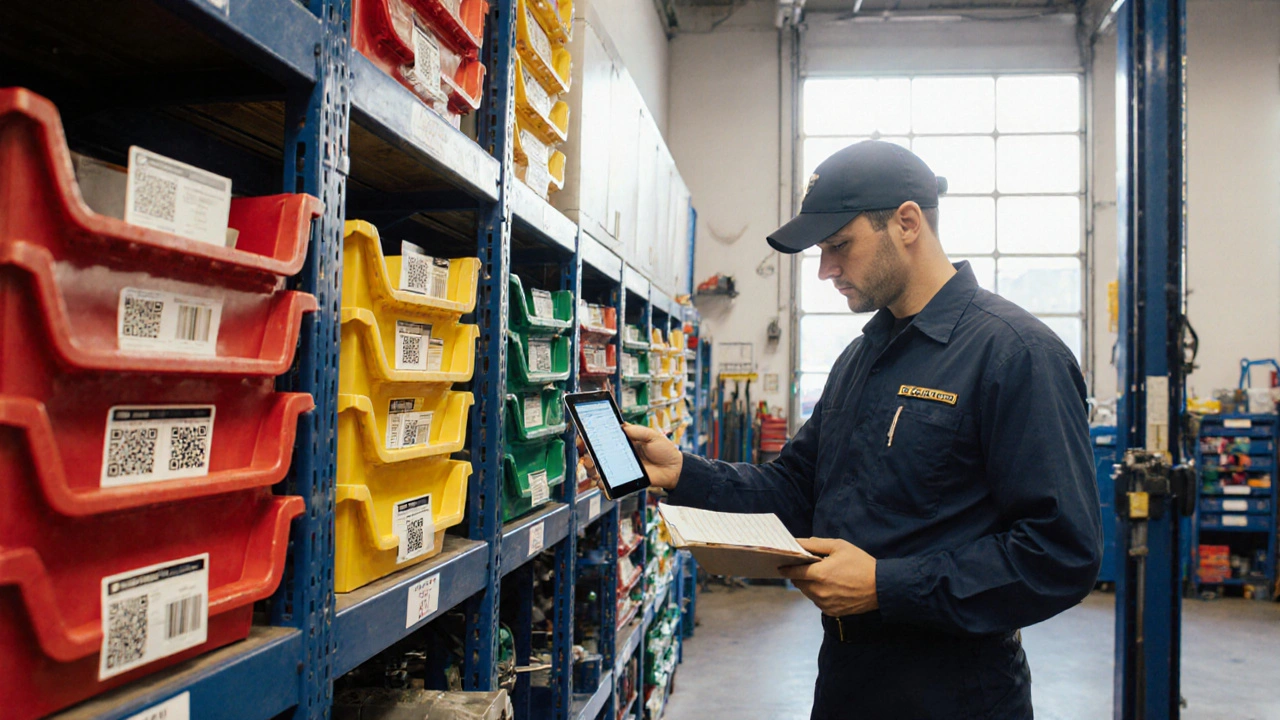Running a fleet of vehicles isn’t just about drivers and routes-it’s about having the right parts when you need them. Imagine a delivery truck breaking down on a Monday morning because a worn-out fuel filter wasn’t replaced. The driver waits. The delivery is late. The customer is unhappy. And you’re stuck paying overtime, rental fees, and lost revenue. This isn’t a rare scenario-it’s the norm for fleets that treat parts inventory like an afterthought.
Why Fleet Parts Inventory Is Different from Regular Stock
Most businesses manage inventory to avoid running out of products to sell. Fleets manage inventory to avoid running out of parts to fix what’s already in use. That’s a bigger problem. A single broken brake line can idle a whole fleet if you don’t have a replacement on hand. Unlike retail stock, fleet parts aren’t sold-they’re consumed. And when they’re gone, the vehicle stops moving.Fleet parts are also unpredictable. A tire might last 60,000 miles on one truck and only 35,000 on another due to terrain, load, or driving habits. Brake pads wear faster in hilly areas. Air filters clog quicker in dusty regions. You can’t rely on averages. You need real-time data tied to actual vehicle usage.
Companies with 50+ vehicles that track part usage by odometer and engine hours see 40% fewer downtime days per year than those who just reorder when something breaks. That’s not luck-it’s systems.
What Parts Should You Keep in Stock?
Not every part needs to be on-site. Keeping everything means wasted cash and cluttered storage. Focus on three categories:- High-failure, low-cost items: Air filters, oil filters, wiper blades, spark plugs, fuses, bulbs. These fail often and cost under $20. Stock 2-3x your monthly usage.
- High-impact, moderate-cost items: Fuel pumps, alternators, starters, thermostats, hoses. These cause major downtime. Keep at least one spare per 10 vehicles.
- Low-failure, high-cost items: Transmissions, turbochargers, ECUs. Don’t stock these unless you have 100+ vehicles. Instead, partner with a local supplier who can deliver within 4 hours.
Use your maintenance logs. Look at the last 12 months. Which parts showed up most often on repair tickets? That’s your priority list. One UK-based waste collection fleet found they replaced radiator hoses every 18 months on average-so they now keep a 24-month buffer on hand. No more emergency calls to suppliers.
Track Parts Like You Track Mileage
If you use telematics to monitor speed, location, and idling time, you should be doing the same for parts. Every time a part is replaced, log it. Not just the part name-log:- Vehicle ID
- Odometer reading at replacement
- Part number and supplier
- Technician who installed it
- Reason for failure (if known)
This turns your inventory from guesswork into a predictive tool. Over time, you’ll see patterns: “Brake pads on Ford Transit vans fail at 42,000 miles on average,” or “Coolant leaks happen more often after winter.” You can then schedule replacements before failure, not after.
Many fleets use simple spreadsheets. But if you have more than 20 vehicles, a basic inventory app like Fleetio or Samsara’s parts module cuts ordering time by 60%. These tools auto-flag low stock, suggest reorder points based on historical use, and even send alerts when a part’s average lifespan is nearing.

Storage and Organization Matter More Than You Think
A messy garage is a slow garage. If your techs spend 20 minutes hunting for a specific bolt or sensor, that’s 100 minutes lost per week across five technicians. That’s over 5,000 minutes a year-nearly 84 hours of lost productivity.Organize your parts area like a hospital pharmacy:
- Use labeled bins with clear, durable tags (not handwritten)
- Group by system: electrical, engine, suspension, HVAC
- Place fast-moving items at eye level
- Use color-coded labels: red for critical, yellow for moderate, green for low-priority
- Keep a digital photo of each bin’s contents on a tablet near the storage area
One logistics company in Bristol switched from open shelves to locked, numbered bins with QR codes. Techs scan the code, see the part’s history, and grab what they need in under 15 seconds. They cut repair time by 22% in three months.
Supplier Relationships Are Part of Your Inventory
Your inventory isn’t just what’s in your warehouse-it’s also what your suppliers can deliver. Don’t just pick the cheapest vendor. Look at:- Delivery speed: Can they get a part to you in 2 hours if needed?
- Return policy: Can you return unused parts without fees?
- Technical support: Do they know your vehicle models inside out?
- Consistency: Do they always send the same part number, or do they swap brands without telling you?
Build a tiered supplier list:
- Tier 1: 1-2 local partners who can deliver within 4 hours for critical parts
- Tier 2: National distributors for common items with 24-hour delivery
- Tier 3: Online retailers for low-use, specialty parts
One fleet manager in Wales keeps a signed agreement with his local diesel specialist: “Emergency part delivery within 3 hours, or we get 20% off next order.” That’s not a perk-it’s insurance.

Common Mistakes That Cost Fleets Money
Even experienced fleets mess this up. Here’s what to avoid:- Buying in bulk to save money: A $150 alternator sitting unused for a year ties up cash. That money could be used to upgrade your tracking system.
- Ignoring expiration dates: Brake fluid, coolant, and batteries degrade. Check dates on stored parts. Old fluid can damage your new system.
- Not training techs on inventory: If your mechanics don’t log replacements, your data is garbage. Make inventory logging part of their daily checklist.
- Reordering manually: Waiting until you’re out of stock is reactive. Use automated alerts. Set reorder points based on usage, not gut feeling.
- Keeping parts from old models: If you’ve retired a vehicle type, sell or recycle its spare parts. Holding onto obsolete stock is just storage waste.
How to Start Improving Your Fleet Parts Inventory Today
You don’t need a $50,000 system to fix this. Start with these five steps:- Grab your last 6 months of repair logs. List the top 10 most replaced parts.
- Count how many of each you have in stock right now.
- Calculate your monthly usage per part. Multiply by 1.5 to set your minimum stock level.
- Label every bin in your storage area. Take a photo of each.
- Assign one person to check inventory every Monday morning. No exceptions.
Do this in one week. In 30 days, you’ll know exactly what you have, what you need, and when you’ll run out. No more surprises. No more panic orders. Just steady, predictable operations.
What Comes Next?
Once your inventory is under control, the next step is predictive maintenance. Link your parts usage data to your telematics system. When a vehicle hits 40,000 miles, auto-generate a work order for the parts that historically fail around that point. That’s how top fleets cut maintenance costs by 30% and extend vehicle life by 2+ years.Parts inventory isn’t about having a full warehouse. It’s about having the right part, in the right place, at the right time. Get that right, and your fleet doesn’t just run-it thrives.
How often should I check my fleet parts inventory?
Check it every Monday morning. That’s the standard for fleets with 10+ vehicles. If you have fewer than 10, check every other day. The goal is to catch low stock before Friday afternoon, when suppliers start closing early. Make it part of a daily checklist for your fleet coordinator.
Should I keep parts for retired vehicles?
Only if you’re still using those vehicles in a limited capacity. If a vehicle model was retired over 3 years ago, sell or recycle its parts. Storage costs add up, and old parts can be incompatible with newer systems. One fleet in Scotland sold retired parts on eBay and made back 40% of their original cost-money they used to upgrade their inventory app.
What’s the best way to track parts usage?
Use a digital fleet management tool that logs part replacements by vehicle ID and odometer. Even a simple app like Fleetio or UpKeep works. If you’re on a budget, use Google Sheets with columns for date, vehicle, part, odometer, and technician. The key is consistency-log every replacement, every time.
Can I outsource my fleet parts inventory?
Yes, but only for non-critical items. Some companies offer vendor-managed inventory (VMI), where a supplier keeps parts on-site at your depot and bills you only when used. This works well for high-turnover, low-cost items like filters and bulbs. But don’t outsource critical components-you need control over timing and quality.
How do I know if I’m overstocking?
If a part sits on your shelf for more than 18 months without being used, you’re overstocking. Calculate your inventory turnover ratio: total cost of parts used in a year divided by average inventory value. A ratio below 2 means you’re holding too much. Aim for 3-5. That means you’re using your stock 3 to 5 times a year-efficient and lean.


Comments
deepak srinivasa
Had a similar issue with our delivery vans last year. We started logging every filter change by odometer and boom-turned out our diesel filters were dying at 28k miles, not 45k like the manual said. Now we replace them at 25k. Saved us three breakdowns in two months. Simple data beats guesswork every time.
November 20, 2025 at 10:12
pk Pk
This is gold. Seriously. I’ve seen so many fleets drown in chaos because they treat parts like a closet full of junk. Organizing by system with color-coded bins? Genius. We just did this last month-techs are no longer yelling across the garage. One guy even said he found a part he’d been searching for since 2021. We’re down 30% in repair prep time. Thanks for the roadmap.
November 22, 2025 at 02:55
NIKHIL TRIPATHI
Love the tiered supplier idea. We’ve got a local guy who drops off alternators in 90 minutes if we call before noon. He doesn’t even charge rush fees anymore because we give him referrals. Also, the 18-month rule for obsolete parts? We cleared out 12 boxes of old Ford Transit gaskets last week. Made $800 on Facebook Marketplace. Bought three new LED bulbs with it. Win-win.
And yeah, logging every replacement-even the tiny ones-is the only way to spot patterns. We used to think our brake pads were failing randomly. Turns out, the ones on the delivery trucks that hit the highway ramps hard? All died at 39k. Now we replace them at 35k. No more midnight calls.
November 22, 2025 at 23:53
Shivani Vaidya
Inventory management is not about storage. It is about foresight.
November 23, 2025 at 22:58
Rubina Jadhav
My boss says we don’t need all this logging. But I started doing it anyway. Last week, we had a brake line burst. I checked the log-same part failed on two other trucks at 41k miles. We checked the rest. Replaced three more before they broke. No one yelled at me. I just smiled.
November 25, 2025 at 08:23
sumraa hussain
OMG I CRIED WHEN I READ THIS. Like, actual tears. We had a truck die on the M4 last Tuesday because we didn’t have a thermostat. I was the one who had to call the tow truck. My hands were shaking. Now I’m the one who checks the bins every Monday. I even made a checklist. I printed it. Laminated it. I’m basically the fleet’s new priest of parts. I’m not okay. But we’re fixed.
November 26, 2025 at 13:35
Raji viji
Wow. Another ‘let’s log everything’ cultist. You people think a spreadsheet is gonna fix bad management? You’re not fixing inventory-you’re just collecting digital dust. I’ve worked with fleets that kept zero parts on-site and just called a 24/7 parts hub. Zero storage. Zero waste. Zero drama. Your ‘predictive’ nonsense is just a crutch for lazy planners. And don’t get me started on QR codes. Who the hell scans QR codes in a grease-stained garage? Just buy the damn part when you need it. Stop overengineering.
November 26, 2025 at 13:43
Rajashree Iyer
Parts inventory… it’s a mirror of our relationship with time. We hoard because we fear scarcity. We ignore expiration dates because we pretend entropy doesn’t exist. Every bolt, every filter-it’s a whisper from the machine, begging us to listen. We treat them like commodities. But they’re not. They’re fragments of motion, frozen in waiting. When you replace a thermostat, you’re not fixing a car. You’re honoring the rhythm of miles, heat, and silence. The real inventory? It’s not on the shelf. It’s in the discipline to show up. Every Monday. Without fail.
November 28, 2025 at 13:11
Parth Haz
Excellent breakdown. I particularly appreciate the emphasis on supplier tiering and the practicality of starting small. Many organizations overlook the importance of consistent data entry-it’s not a burden, it’s an investment. Our team implemented the Monday check-in protocol last quarter. We’ve seen a 27% reduction in emergency orders and a measurable increase in technician morale. Thank you for providing actionable, not theoretical, guidance.
November 29, 2025 at 18:18